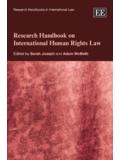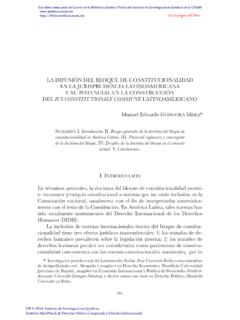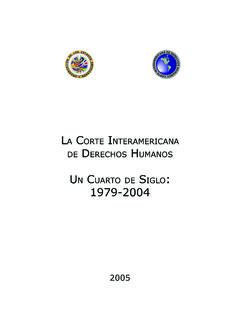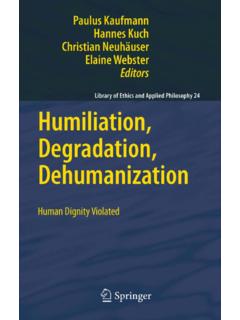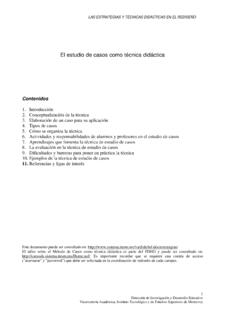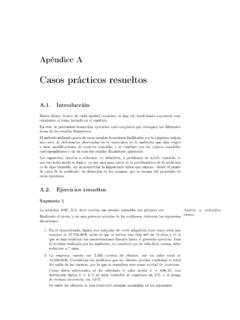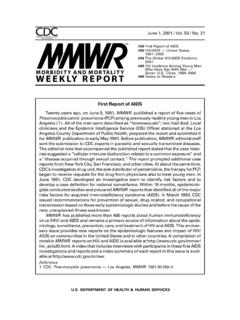Transcription of Inter-American Court of Human Rights Case of González et ...
1 Inter-American Court of Human Rights Case of Gonz lez et al. ( cotton field ) v. mexico Judgment of November 16, 2009 (Preliminary Objection, Merits, Reparations, and Costs) In the case of Gonz lez et al. ( cotton field ), the Inter-American Court of Human Rights (hereinafter the Inter-American Court , the Court or the Tribunal ), composed of the following judges:1 Cecilia Medina Quiroga, President Diego Garc a-Say n, Vice President Manuel E. Ventura Robles, Judge Margarette May Macaulay, Judge Rhadys Abreu Blondet, Judge, and Rosa Mar a lvarez Gonz lez, Judge ad hoc; also present, Pablo Saavedra Alessandri, Secretary, Emilia Segares Rodr guez, Deputy Secretary, pursuant to Articles 62(3) and 63(1) of the American Convention on Human Rights (hereinafter the Convention or the American Convention ) and Articles 29, 31, 37(6), 56 and 58 of the Rules of Procedure of the Court2 (hereinafter the Rules of Procedure ), delivers this judgment.
2 I 1 On December 15, 2007, the President of the Court at the time, Judge Sergio Garc a Ram rez, a Mexican national, ceded the Presidency to Judge Cecilia Medina Quiroga and informed the Court that he was disqualified from hearing this case. Judge Garc a Ram rez explained the reasons for this disqualification, which the Court accepted. On December 21, 2007, the State was advised of this decision and informed that it could appoint a judge ad hoc to take part in the hearing of the case. On February 29, 2008, following two extensions, the State appointed Ver nica Mart nez Solares as judge ad hoc. On September 18, 2008, the representatives of the alleged victims objected to this appointment, indicating that Ms. Mart nez Solares did not fulfill one of the requirements established in Article 52 of the [American Convention] to be a judge of the Inter-American Court .
3 On October 30, 2008, the Court issued an order in which it indicated that Ms. Mart nez Solares did not comply with the requirements to participate as judge ad hoc in the instant case. In the order, the Court gave the State a certain time to appoint another judge ad hoc. On December 3, 2008, the State appointed Rosa Mar a lvarez Gonz lez to perform this function. Additionally, for reasons of force majeure, Judge Leonardo A. Franco did not participate in the deliberation and signature of this Judgment. 2 As established in Article 72(2) of the current Rules of Procedure of the Inter-American Court , the latest amendment to which entered into force on March 24, 2009, [c]ases pending resolution shall be processed according to the provisions of these Rules of Procedure, except for those cases in which a hearing has already been convened upon the entry into force of these Rules of Procedure; such cases shall be governed by the provisions of the previous Rules of Procedure.
4 Accordingly, the Rules of Procedure of the Court mentioned in this Judgment correspond to the instrument approved by the Court at its XLIX Regular Period of Sessions held from November 16 to 25, 2000, partially amended by the Court at its XLI Regular Period of Sessions held from November 20 to December 4, 2003. 2 INTRODUCTION OF THE CASE AND PURPOSE OF THE DISPUTE 1. On November 4, 2007, under Articles 51 and 61 of the Convention, the Inter-American Commission on Human Rights (hereinafter the Commission or the Inter-American Commission ) presented an application against the United Mexican States (hereinafter the State or mexico ), which gave rise to the instant case. The initial petition was presented to the Commission on March 6, 2002. On February 24, 2005, the Commission approved Reports Nos. 16/05, 17/05 and 18/05, declaring the respective petitions admissible.
5 On January 30, 2007, the Commission notified the parties of its decision to joinder the three cases. Subsequently, on March 9, 2007, it approved the Report on merits No. 28/07, in accordance with Article 50 of the Convention, with specific recommendations for the State. This report was notified to the State on April 4, 2007. Upon considering that mexico had not adopted its recommendations, the Commission decided to submit the case to the jurisdiction of the Court . The Commission appointed Commissioner Florent n Mel ndez and Executive Secretary Santiago A. Canton, as delegates, and Elizabeth Abi-Mershed, Deputy Executive Secretary, and Juan Pablo Alb n, Marisol Blanchard, Rosa Celorio and Fiorella Melzi, Executive Secretariat specialists, as legal advisers. 2. The application relates to the State s alleged international responsibility for the disappearance and subsequent death of the Mss.
6 Claudia Ivette Gonz lez, Esmeralda Herrera Monreal and Laura Berenice Ramos Mon rrez (hereinafter Mss. Gonz lez, Herrera and Ramos ), whose bodies were found in a cotton field in Ciudad Ju rez on November 6, 2001. The State is considered responsible for the lack of measures for the protection of the victims, two of whom were minor children, the lack of prevention of these crimes, in spite of full awareness of the existence of a pattern of gender-related violence that had resulted in hundreds of women and girls murdered, the lack of response of the authorities to the disappearance [..]; the lack of due diligence in the investigation of the homicides [..], as well as the denial of justice and the lack of an adequate reparation. 3. The Commission asked that the Court declare the State responsible for the violation of the Rights embodied in Articles 4 (Right to Life), 5 (Right to Humane Treatment), 8 (Right to a Fair Trial), 19 ( Rights of the Child) and 25 (Right to Judicial Protection) of the Convention, in relation to the obligations established in Articles 1(1) (Obligation to Respect Rights ) and 2 (Domestic Legal Effects) thereof, together with failure to comply with the obligations arising from Article 7 of the Convention on the Prevention, Punishment and Eradication of Violence against Women (hereinafter the Convention of Bel m do Par ).
7 The application was notified to the State on December 21, 2007, and to the representatives on January 2, 2008. 4. On February 23, 2008, the Asociaci n Nacional de Abogados Democr ticos A. C., the Latin American and Caribbean Committee for the Defense of Women s Rights , the Red Ciudadana de No Violencia y por la Dignidad Humana and the Centro para el Desarrollo Integral of the Mujer A. C., representatives of the alleged victims (hereinafter the representatives ),3 presented their brief with pleadings, motions and evidence (hereinafter pleadings and motions brief ). In addition to the allegations submitted by the Commission, the representatives asked that the number of victims be expanded to eleven women and that the Court rule on the alleged arbitrary detention, torture and violation of due process of three other people. In addition to the Articles 3 On December 14, 2007, said organizations advised the Court that they had appointed Sonia Torres Hern ndez as their common intervener in accordance with Article 23(2) of the Court s Rules of Procedure (merits case file, volume V, folio 1936).
8 3invoked by the Commission, the representatives asked that the Court declare the State responsible for violating the Rights embodied in Articles 7 (Right to Personal Liberty) and 11 (Right to Privacy [Dignity and Honor]) of the Convention, all in relation to the general obligations arising from Articles 1(1) and 2 thereof, as well as Article 7 of the Convention of Bel m do Par , in connection with Articles 8 and 9 thereof. Furthermore, they asked the Court to declare that the State had violated the right embodied in Article 5 of the American Convention to the detriment of the three alleged victims identified by the Commission. 5. On May 26, 2008, the State presented its brief in answer to the application and with observations on the pleadings and motions brief (hereinafter answer to the application ). This brief questioned the Court s jurisdiction to examine the alleged violation of the Convention of Bel m do Par.
9 In addition, it contested the expansion of the number of victims proposed by the representatives, and partially acknowledged its international responsibility. The State appointed Juan Manuel G mez-Robledo Verduzco as its agent, and Patricia Gonz lez Rodr guez, Joel Antonio Hern ndez Garc a, Mar a Carmen O ate Mu oz, Alejandro Negr n Mu oz and Armando Vivanco Castellanos as its Deputy Agents. 6. On July 16, 2008, having examined the answer to the application, the President of the Court (hereinafter the President ) informed the State that the allegations concerning the Convention of Bel m do Par constituted a preliminary objection. Consequently, in accordance with Article 37(4) of the Rules of Procedure, she granted the Commission and the representatives 30 days to submit written arguments. The arguments were presented on August 20, and September 6, 2008, respectively. II PROCEEDING BEFORE THE Court 7.
10 On August 21, 2008, the representatives expressed their intention of commenting on relevant information contained in the attachments to the answer to the application and providing information on supervening facts. On August 26, 2008, the President refused the representatives request to submit their comments on the attachments to the answer to the application at this procedural stage, because they had failed to justify why Article 39 of the Rules of Procedure should be applied. Nevertheless, the President advised the representatives that they could submit any allegations they deemed pertinent during the oral proceedings or in their final written arguments. 8. On September 6, 2008, the representatives submitted a brief in which, inter alia, they commented on the observations made by the Mexican State in its answer to the application. On September 9, 2008, the President considered that this part of the brief would not be taken into account, because the Rules of Procedure made no provision for its presentation and it had not been requested.
